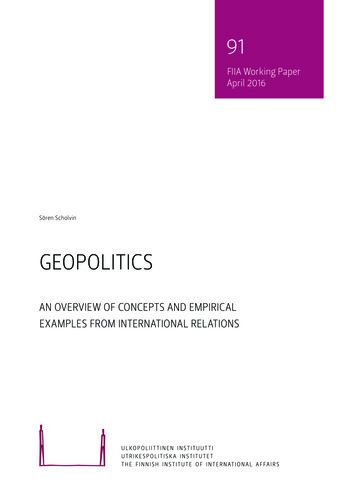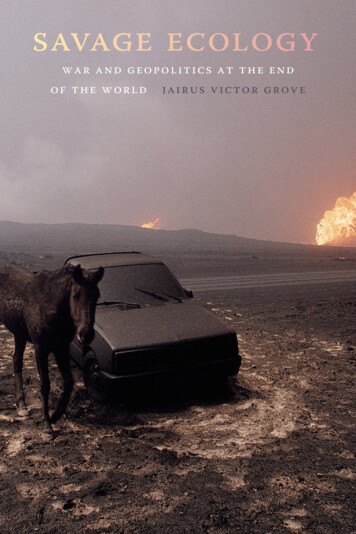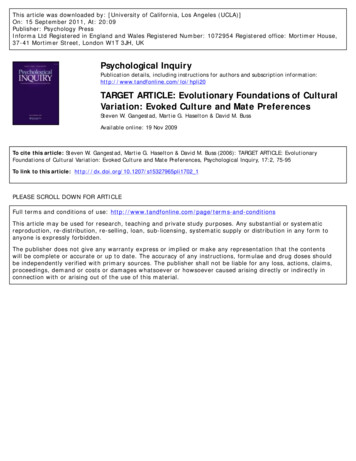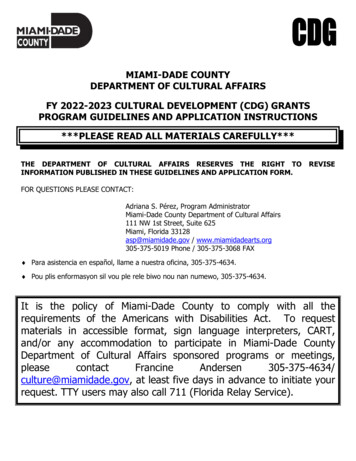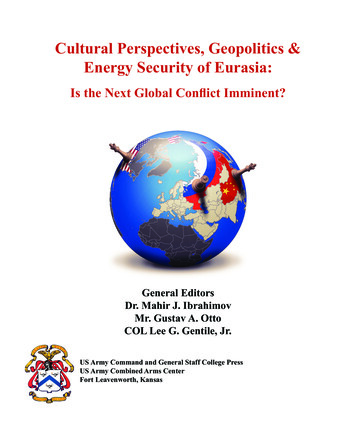
Transcription
Cultural Perspectives, Geopolitics &Energy Security of Eurasia:Is the Next Global Conflict Imminent?General EditorsDr. Mahir J. IbrahimovMr. Gustav A. OttoCOL Lee G. Gentile, Jr.US Army Command and General Staff College PressUS Army Combined Arms CenterFort Leavenworth, Kansas
Cover image courtesy of Culture, Regional Expertise and Language Management Office(CRELMO).
Cultural Perspectives, Geopolitics &Energy Security of EurasiaIs the Next Global Conflict Imminent?General EditorsDr. Mahir J. IbrahimovMr. Gustav OttoCOL Lee G. Gentile, Jr.A CGSC Press BookPublished by The Army University PressUS Army Command and General Staff College PressUS Army Combined Arms CenterFort Leavenworth, Kansas
Library of Congress Cataloging-in-Publication DataLibrary of Congress Cataloging-in-Publication DataNames: Ibrahimov, Mahir, 1956- editor. Otto, Gustav A., editor. Gentile,Lee G., Jr., editor. U.S. Army Command and General Staff College Press,issuing body.Title: Cultural perspectives, geopolitics, & energy security of Eurasia : isthe next global conflict imminent? / general editors: Mahir J. Ibrahimov,Gustav A. Otto, and Lee G. Gentile, Jr.Other titles: Cultural perspectives, geopolitics, and energy security ofEurasia Is the next global conflict imminent?Description: Fort Leavenworth, KS : US Army Command and General Staff CollegePress, 2017. Includes bibliographical references and index.Identifiers: LCCN 2016057665 ISBN 9781940804316 (paperback)Subjects: LCSH: Geopolitics--Eurasia--History--21st century. Geopolitics--Eurasia--History--20th century. United States--Foreignrelations--Eurasia. Eurasia--Foreign relations--United States. Russia(Federation)--Military policy. Globalization--Eurasia. Globalization--Religious aspects. Language and culture--Eurasia.Classification: LCC JC319 .C85 2017 DDC 355/.03305--dc23 SUDOC D 110.2:EU7LC record available at Caution-https://lccn.loc.gov/20160576652017US Army Command and General Staff College Press publications cover a wide varietyof military topics. The views expressed in this publication are those of the author(s) andnot necessarily those of the Department of the Army or the Department of Defense.The seal of the US Army Command and General Staff College authenticates thisdocument as an official publication of the US Army Command and General Staff CollegePress. It is prohibited to use this official seal on any republication without the expresswritten permission of the US Army Command and General Staff College Press.EditorJennifer B. Fikeii
ForewordGeopolitics and the socio-cultural aspects of regional affairs continue to change at a rapid pace. Military decisions that directly affect strategic outcomes rely heavily on cohesively understanding the operatingenvironment and associated regional cultures of our allies and our adversaries. Army leaders at all echelonsmust be able to recognize and adapt in stride or ahead of these geopolitical and cultural changes in theoperating environment and understand how they can directly affect broader mission outcomes. The USArmy’s Culture, Regional Expertise, and Language (CREL) Program provides a mechanism for the Armyto prepare for its premier land force to operate within a region’s indigenous cultures.This anthology, Cultural Perspectives, Geopolitics & Energy Security of Eurasia: Is the Next GlobalConflict Imminent? Volume 1, written under the auspices of the CREL Management Office (CRELMO),provides insight and observations on the importance of the Eurasia region, including Russia and othercountries of the former USSR. The articles that make up this work provide a detailed description of regionalrealities, including a contextual discussion of the current Ukraine situation, viewed through the prism ofRussia’s traditional military-strategic culture. As with all countries in the Eurasian region, Russia’s traditional strategic interests play a critical role in the geopolitical and socio-cultural situation in that region.The insights offered in this volume are important for Army professionals who lead Soldiers in a varietyof missions across the globe. The anthology goes beyond the obvious military strategic nexus and seeks toidentify new spaces for consideration by planners and policymakers alike.I know you will both enjoy and benefit from this anthology.John S. KemMajor General, US ArmyProvost, Army Universityiii
ContentsForeword.iiiIntroduction.viiSection 1: History and Geopolitical TrendsChapter 1: Russian and US Policy in the Near Abroad, 1985 – 1996: Through the Lens of theFirst US Army Culture and Language Advisorby Dr. Mahir J. Ibrahimov.1Chapter 2: Strategic Central Asiaby US Ambassador (Ret) Richard E. Hoagland.21Chapter 3: Eurasia’s Unequal Partners: China-Russia Relations—Past, Present, and Futureby Dr. Joseph “Geoff” Babb.33Chapter 4: Made by History: Power, Energy, Security, and Conflict, The First World Warin the Caucasus and North Persia in 1918by Major Roland Minez.45Chapter 5: Courting Cuba: America’s Girl-Next Door; Eurasia’s Distant Beautyby Dr. Prisco Hernández.63Chapter 6: In the Shadow of Destruction: How Nuclear Weapons Underwrite Russia’sGlobal Strategyby Colonel Lee G. Gentile, Jr.83Chapter 7: Ukraine’s Hidden Battlefieldby Robert Kurz.93Chapter 8: Countering Russian Revanchism: US and Western Options to Thwart the Bear.101by Gustav Otto.101Section 2: Rise of Sub-State Actors: Environmental, Socio-Cultural and Religious Aspects ofthe Operational EnvironmentChapter 9: Why Climate Change is an Issue of National Securityby Dr. W. Chris King. 113Chapter 10: Political Islam: History, Geopolitical Implications, Cultural, Psychologicaland Religious Aspects of Life and Deathby Dr. Mahir J. Ibrahimov.121Chapter 11: The Syria, and Syrians, I Knewby Gary Hobin.137v
Chapter 12: Prosecuting Radical Islamby Colonel (Ret) Nathan Slate.145Section 3: Military Applications of Culture and Language in the Operational EnvironmentChapter 13: Army Culture and Foreign Language Strategy: The Global Front Withinthe Context of the Home Frontby Dr. Tseggai Isaac .151Chapter 14: Cultural Considerations, Regional Expertise and Skill Building in theOperational Environment (OE)by Dr. Mahir J. Ibrahimov.167Chapter 15: Orthodoxy, Ukraine and the Symphonia between the Church and Societyby CH (MAJ) Seth H. George.173Chapter 16: The Army’s Approach to Culture and Language Applications byDr. Mahir J. Ibrahimov.183Conclusion.201About the Authors.203vi
Table of FiguresFigure I.1 World GDP Projections. xiiFigure 1.1 Russian Strategic Military Culture. 2Figure 1.2 Impacts of Afghan-Soviet War. 3Figure 1.3 Soviet Soldier Cultural Awareness Guide. 4Figure 1.4 Pashtuns. 5Figure 1.5 Post-Cold War and Post-Soviet Era NATO Membership. 6Figure 1.6 Post-Cold War: Commonwealth of Independent States. 7Figure 1.7 Gas Pipelines to Europe. 17Figure 3.1 Asia Map. 34Figure 4.1 Area of Operations. 47Figure 7.1 Map of Ukraine and region. 93Figure 7.2 Methods and Ways of Conducting a New-Type of War. 95Figure 9.1 Major Impacts of Climate Change.116Figure 10.1. Rings of Loyalty. 120Figure 10.2 Muslim Prayer. 121Figure 10.3 Muslims Praying. 122Figure 10.4 Spread of Islam. 123Figure 10.5 Branches and Schools of Islam. 129Figure 14.1 Appropriate Gestures and Body Language. 166Figure 14.2 Basic Dos and Don’ts During the Negotiation Process. 166Figure 16.1 LREC Standards Across the Total Army. 179Figure 16.2 Training Source (Means) Linkage Across the Army. 180Figure 16.3 CJCSI 3126.01A Proficiency Levels and Corresponding ALDS Leader Attributes. 182Figure 16.4 Cross Cultural Competencies. 183Figure 16.5 CREL Assessment. 184Figure 16.6 CREL Expectations. 184Figure 16.7 CREL Expectations (Continued). 185Figure 16.8 CREL Operational Support. 187Figure 16.9 CREL Implementation Approach. 189Figure 16.10 Leader Attributes. 191Figure 16.11 Cultural Awareness and Language Training Package. 193Figure 16.12 FCoE Culture and Foreign Language Resource examples. 194Figure 16.13 Cultural Awareness Lesson Plan. 195vii
Introduction1Dr. Mahir J. IbrahimovWe have learned many lessons over the last 10 years, but one of the most compellingis that whether you are working among the citizens of a country, or working with theirgovernment or Armed Forces-nothing is as important to your long term success as understanding the prevailing culture and values.GEN Raymond OdiernoChief of Staff of the ArmyCulture, Regional Expertise and Language (CREL) creates a sustainable advantage forregionally aligned forces in any combination of indigenous cultures by providing trainingand education tools that enhance Professional Military Education, Pre-Deployment andFunctional Training. CREL is a critical strategic security concept to prepare globally responsive and regionally aligned forces that work with a variety of partners including hostnation militaries and populations to execute our Prevent, Shape and Win strategic role.MG Christopher P. HughesDeputy Commanding GeneralUS Army Combined Arms Center2Globalization, the Internet, and instant access to worldwide media and news have encouraged the merging or partnering of ideological groups that oppose the US and/or US policies. These groups operate inpan-regional and multi-regional spaces comprised of numerous cultures, both friendly and hostile. It appears likely that during the coming decades the operational environment will be characterized by persistentand unpredictable conflicts in battle spaces of multiple foreign cultures. The US National Security Strategy(NSS), in particular the Department of Defense’s National Defense Strategy, must be prepared to ensurethat the nation’s military forces can effectively operate with multinational and host nation partners againstsophisticated and adaptive adversaries in order to achieve US objectives. This dictates that Soldiers of everyrank must become “culturally astute” about the areas in which they operate.3This anthology’s insights and observations of the socio-cultural aspects and geopolitics, from bothhistorical and current perspectives, re-emphasize the importance of the Eurasia region, including Russiaand other countries of the former USSR. The book’s detailed description of the realities of the region isespecially revealing in the context of the current situation in Ukraine viewed through the prism of Russia’straditional military-strategic culture. These traditional strategic interests, informed by inextricable historical and socio-cultural factors, are playing a critical role in the situation in and around Ukraine.Russia’s intervention in Syria has changed the military and diplomatic dynamic in the regional crisis and left the US to search for a new approach. US influence in the region might be in jeopardy. Sometraditional American allies are already talking with Moscow about how to resolve the crisis, which couldpotentially change the strategic landscape.ix
Several chapters of the book describe the beginnings and the current approaches of the US Army’sCulture and Language Program and its continuous importance for our military missions in and amongindigenous cultures such as those in Eurasia. Others go beyond the obvious military strategic aspects tryingto identify new areas for consideration by our analysts and policymakers.Global geopolitics are rapidly changing and understanding the socio-cultural and economic aspects ofthe major and regional players are becoming even more important. The strategic outcomes of our decisionswill depend at a greater extent on understanding of the above factors of the adversaries.Ongoing active Information Campaign (IC), Electronic Warfare (EW), Cyber, etc. in the so called“Grey Zone,” (a term used by US Army Special Operations Forces for non-traditional, unconventional military capabilities) from multiple regional and global players are exacerbating the Operational Environment(OE). All these make the situation even more unpredictable and reinforces the importance of understandingthe historical, socio-cultural and regional considerations.One example that demonstrates the extent of the current complexity and sensitivity in the OE is thedocument titled “Clarification Note to the Decision of employment of the military units Sever (North) inUkraine.” This directive, equivalent to US or Western military Operations Order (OPORD), was allegedlydisseminated by the Russian Defense Ministry in the summer of 2015 as a “Top Secret” document.4It’s still unknown if this is a real document which was leaked, or a result of Ukrainian counter-propaganda. In any case, whoever wrote it is very familiar with the former Soviet/or Russian military doctrine and islikely a graduate of a top former Soviet/Russian military institution such as M.V. Frunze Military Academyor Marshal Voroshilov Military Academy of the General Staff. Also, there is no map, which would normallybe attached to the document, another indicator that the document might not be real and absence of the datereinforces that point. But there is the related “Phasing Matrix (schedule) of Preparation and launching ofthe First Targeted Fire Attack of the Military Units of Sever in a Special Operation.” The document is alsosigned by LTG V. Astapov, the Commander/Chief of the HQ for the Western Military District, and MG I.Kovalenko, the Chief of the Operational Department (of the same HQ for the Western Military District).5This document underlines how a preventive Information Operations (IO) Campaign based on understanding of potential individual approaches leveraged by Russia towards different regions would likelybe one of the realistic tools applied. Also, the violations of the principles of the international law could beemphasized to try to paralyze further actions in ways similar to those used in the Crimea annexation. Depending on the region/country, other internal tools of influence could be leveraged. The bottom line is tolearn how Russia and other adversaries operate and apply the same methodology to achieve our objectives.There have always been discussions about the principles of territorial integrity and self- determination.Where is the fine line between these concepts? I believe understanding how these two concepts interact isthe main lesson that can be learned from Russia’s policies in the region.The Russian annexation of Crimea represents a different approach compared to that taken by Russia inthe Donetsk and Luhansk regions of Donbas in the east of Ukraine. The justification of the Crimea approachwas based on the referendum which, from the perspective of Russian and pro-Russian Crimea leaders, reflected the aspiration to rejoin the rest of Russia. This reunification would address the historical injusticeperpetrated when former Soviet leader Nikita Khrushchev decided to transfer Crimea from the RussianSoviet Socialist Republic to the Ukrainian Soviet Socialist Republic in 1954. Thus, according to this viewpoint, the annexation fulfilled the principle of self-determination of the Crimean people.x
So what about the Crimean Tatars with their recognized leader Mustafa Dzhemilev, former Chairman ofthe Mejlis of the Crimean Tatar people, who opposed and continues to oppose the annexation? What aboutother so called “hot spots” and annexations which were supported by Russia in early 90s and later, such asNagorno-Karabakh, Abkhazia-Georgia-Ossetia and other conflicts? With the annexation of Crimea, Russiahas once again violated the territorial integrity and sovereignty of a country based on the world order agreedupon by the international community after the World War II and post-Soviet, post-Warsaw Pact BudapestMemorandum.The Baltic republics, which are presently NATO members, fall under article 4 and 5 of the NATO constitution which provide a protection mechanism in case of aggression against them. Russia would likelyapply tactics towards that region similar to its approaches in Luhansk and Donetsk regions of Donbass, andnow in Moldova and elsewhere, rather than openly attacking those countries which might cause a NATOresponse. There are significant ethnic Russian or Russian speaking communities in those countries andRussia has historical expertise and relevant socio-cultural aptitude at leveraging them to ignite tension atcertain times to meet its geopolitical objectives.We can learn from both Russian experiments in Crimea as well as in Eastern Ukraine. The main lesson is that Russia will likely continue applying a combination of approaches, mentioned above, as well associo-economic pressures which we witnessed in case of Ukraine and elsewhere. Open military involvement, like that which happened in Georgia in 2008, is unlikely, unless circumstances similar to that conflictemerge.Russia’s strategic change is driven mostly by its concern over the NATO’s expansion at the expense offormer Warsaw Pact countries (Eastern Europe) and former Soviet republics (Latvia, Estonia and Lithuania). Not surprisingly, the Lithuanian and Estonian defense ministries have expressed alarm at the increasedmilitary activity, and drawn comparisons with moves prior to the Russian invasion of Crimea. As oneanalysis of Russian intents in the Baltic region put it, “Russia’s frequent snap military drills near its easternEuropean neighbors could be part of a strategy that will open the door for a Russian offensive on the Balticstates.”6It is believed that Georgia’s and Ukraine’s aspirations to join NATO were the principal reasons for Russian relevant violent policies towards those former Soviet satellites. As a result of all the above, relationsbetween the West and Russia have deteriorated to their lowest point since the end of the Cold War, erodingglobal geopolitical stability and damaging trade and economic relations between major global and regionalpowers.Rapidly changing regional and global geopolitics are influenced and complicated by broader developments such as China’s increasing influence, especially its gradual economic, military, and strategic rapprochement with Russia, the countries of central and south-west Asia, Transcaucasia, among other regionsof the world.Estranged from the West over NATO Expansion, and especially because of the situation in Ukraine,which led to the Western sanctions, Russia seeks closer economic and political rapprochement with China.As a result, a coalition of new alliances were formed. The Shanghai Cooperation Organization (SCO), coalition of Brazil, Russia, India, China and South Africa (BRICS), Eurasian Customs Union (ECU) amongothers are mostly aimed at opposing US economic and strategic dominance. Specifically, arms deals between China and Russia are growing and amount to at around 2 billion annually, including a potential 3billion deal for S-400 missile systems.xi
It is obvious that Russia-China rapprochement presents a profound challenge to the United States. Therealpolitik question for US policy makers would be how to prevent this historically unlikely alliance between the two major global and regional players. The same question would apply to evolving Russia-Irancollaboration in different areas, including military cooperation, which have never been friends in the past.Turkey renewed its efforts to rebuild ties shattered by downing of a Russian warplane last year. PresidentRecep Tayyip Erdogan visited Russia in August 2016 as part of that effort.At the same time, Turkey’s relations with traditional allies – the United States and Europe – show increasing strain amid Ankara’s crackdown following a failed coup. It is believed a new alliance between Turkey, a NATO member, and Russia, is an example of the latter power’s strategy to split NATO. The UnitedKingdom’s Brexit in summer 2016 vote shows the likelihood for more strain in the EU and NATO as well.That new important development would potentially meet the objectives of the anti-American economicand strategic agenda in Europe, would diminish US influence among its traditional allies, already affectedby Europe’s pragmatic considerations of close trade and economic relationships with Russia and China.Adding to that complexity was Poland’s decision in July 2016 to file a formal objection against Russia’sproposed “Nord Stream 2” gas pipeline.7 Observers say that construction of that pipeline would divide Europe from the US, isolate Ukraine, and reinforce Moscow’s energy dominance for another generation. Thisinitiative is another example of how consistent pipeline politics serves as an important tool of regional andglobal geopolitical efforts to achieve strategic objectives.Figure I.1. World GDP Projections. Developed from the World Bank website.8Changing geopolitical and economic dynamics have also added uncertainty and complexity to Eurasianaffairs. These trends are clearly reflected in the graphic depicted below of the World Bank data, adjusted forxii
the purposes of this anthology. The statistics are based on billions of dollars of national GDPs of the majorregional and global powers. Clearly, China’s economy is projected to continue growing while the economicoutput of the European Union, Russia, and the UK will remain static or even decrease.The rise and expansion of the Islamic State of Iraq and Syria (ISIS), Russia’s active political and military involvement in Syria, and the largest refugee crisis since World War II contribute to the challenges inEurasia and present a profound threat to the national security interests of the US and the West.The authors’ observations and expertise presented in this volume provide valuable insight to help betterunderstand and contextualize the current and emerging realities of this critical region. These insights andobservations on how the US is perceived in the Middle East, Asia, and the former USSR deserve the attention of American readers because they come from scholars and practitioners who combine insight practicalknowledge as well as a rich academic expertise. This combination brings a better understanding of the localculture and the regional and ethnic conflicts that have shaped it. It tells us a lot about a corner of the worldwhere death is preferable to dishonor and honor is defined in a quite different way than in Western society.The anthology includes the chapters from a wide range of regions, including the Western Hemisphere.This broad approach reflects the fact that regional and global geopolitics are interconnected socio-culturally, economically and historically. Russia, with significantly fewer resources compared to the former USSR,is still playing an increasingly active role on the Eurasian geopolitical landscape. One of the factors whichinfluence current Russian foreign policy not only in Eurasia and beyond is the concept of “Eurasianism.”The significance of the term “Eurasian” has changed to a great extent, but still suggests strategic rivalry andmost importantly has a socio-cultural content. It is believed that it still represents a significant force withinRussian strategic and military thinking which was shaped over the centuries.9 The Army’s recent “RussianNew Generation Warfare in Ukraine” study which required of this author’s travel to Ukraine as well as other Eurasia related research have clearly identified significant gaps: shared historical, cultural and languageheritage between Russia and Ukraine that would be difficult to break.At the same time, there is a gap and lack of understanding and appreciation by the US of the indigenous cultures, including those of the Eurasia region. The new generation of warfare is already ongoing inUkraine and other regions. Operations are occurring within the “gray zone.” Russians are effective in theseareas because they have been active in operations like this for centuries and have a socio-cultural aptitudeand common linguistic capabilities. Russians understand the value of culture and soft power from havingexperienced it during the Soviet period and before.Eurasianism, has been an important factor for the Russian culture which was shaped for centuries ofinvolvement on two continents. Debates still continue about Russia itself: is it part of the West or Asia? Wemust remember that the Soviet Union lost approximately 30 million lives to the Nazis and has been invadedby others such as Napoleon and the Mongols.10 This historical loss and suffering have been the key in theformation of the Russian mindset. Consequently, Russia is currently seeking to create security and economic organizations that could be used to rival the existing structures such as NATO and the World Bank.Russia, China, Iran, and other countries have undertaken these and other steps which are not in the nationalsecurity interests of the United Sta
Energy Security of Eurasia Is the Next Global Conflict Imminent? General Editors Dr. Mahir J. Ibrahimov Mr. Gustav Otto COL Lee G. Gentile, Jr. A CGSC Press Book Published by The Army University Press US Army Command and General Staff College Press US Army Combined Arms Center Fort Leavenworth, Kansas

